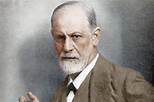DREAM DICTIONARY
Made Of Dreams
Search
Freud - The Interpretation Of Dreams - Introduction - 2










Freud - The Interpretation Of Dreams - Introduction - 2
Clearly there is no limit to the web meanings spun by 'free association', or to put it the other way round, in Freud's language, 'the degree of condensation is - strickly speaking - indeterminable'.But Freud found that not only did each element of a manifest dream tend to lead to some latent common denominator ; but a single latent thought was also prone to be represented by several manifest elements - an interrelationship he referred to as ' over determination'.
Freud attempted to unravel the principles or 'grammar' which governed the transformation of underlying thoughts into a remembered dream, a process which he designed 'dream work'. As well as ' condensation' and 'over-determination', he invoked 'displacement', by which he meant the shift invalue that enabled elements in the manifest dream to seem important when they appeared peripheral to the underlying content; and 'symbolism', the process whereby images of one thing came to suggest or stand for another.
Perhaps the most vulgar misconception concerning The Interpretation Of Dreams is that in it Freud 'invented' sexual symbolism - the representation of male sex organs by objects such as cigars and umbrellas or wild beasts, female sex organs, by round or hollow containers, flowers, fruit, etc. But witness for example the 'Song of Songs':
BRIDE: Sweet dove, already you are in the cleft of my rock, enclosed in my cavern. Look up, let me see your handsome face. Speak to me, let me hear your sweet voice.
GROOM: Let us fetch us little foxes, little foxes that plunder the vineyards, for our vineyards are full of grapes .
BRIDE: My beloved is mine, as I am his. He browses among my lilies. Until the day dawns and the shadows fade, turn again to me, my beloved! Be like a wild goat or a hart grazing on the hills of Boter.Such, symbolism, as Freud points out, has been prevalent in folklore, myths, legends, idiomatic phrases, proverbs, and witticisms since time immemorial. Freud merely expanded the list to include dreams.
In fact, the general currency of sexual symbolism presented a problem for the main thesis of the book, since Freud found that the meaning of a symbol could not be derived ( as his method demanded) from the idiosyncratic associations of the dreamer. His recofnition of the role of symbolism in dreams forced him to modify the method to include direct interpretations based on the analyst's knowledge of common usage.
All the tropes and conceits familiar to the literary imagination, Freud attributes to the language of dreams. But he was certianly not unique among his generation in doing so. The Scottish writer Robert Louis Stevenson, also fascinated by the anatomy of dreams, expressed a similar idea several years earlier in a letter to his friend Owen Wiser: dreams are merely novels, they are made with every sort of literary trick; a word stands for a year, if it is the right word, equally with the reader and the dreamer.'
What distinguishes Freud's approach from Stevenson's is the emphasis on the dream as an agent of misinformation. Where novelist employs imaginative devices in order to breathe life into a fictional world as an agent of misinformation. Where a novelist employs imaginative devices in order to breathe life into a fictional world, to create and communicate a 'narrative truth', Freud's hidden author (albeit in order to make his work acceptable to the mind's putative Victorian censor) is set upon telling lies.
Because Freud works backwards from manifest dream to latent content and then retraces his steps, inserting a casual arrow that points from latent content to manifest dream, his logic is open to question. The philosopher Frank Cioffi has argued that condensation, displacement and symbolisation are not attributes of dream production at all, but post hoc instruments for imposing a spurious burden of meaning 'not mechanisms by whose operation the symptom, dream etc,. was constructed, but rules for "working a piece of fancy into it".' It is for the reader to judge the force of this sceptical challenge.
Two features of Freud's rhetoric, however, stand out. They account both for the seductive appeal of argument and for its vulnerability to philosophical criticism. The first is a creeping tendency to excessive generalisation, and the second a blithe indifference to self-contradiction. If we look at the development of the wish-fulfilment hypothesis, we can see him slide from a moderate, almost self-evident, proposition into an outrageous generalisation that requires all the ingenuity he can muster to defend.
When reviewing the scientific literature, he quits reasonably states that in the analysis of dream-life, ' we are reminded at every step that it is in admissible to frame general rules without making provision for qualifications by introducing such terms as "frequently", "as a rule", "in most cases ", and without being prepared to admit the validity of exceptions .' Yet shortly afterwards he has moved from the demonstration that wish-fulfilment often occurs in dreams to the assertion that disguised wish-fulfilment is the meaning of every dream.
Naturally such a gauntlet was taken up by patients , readers and critics alike who proceeded to furnish Freud with counter-examples - dreams of painful frightening experiences which could not possibly have been desired. And one by one, Freud supplies the answers.
The wish is latent not manifest. A woman who dreams that she wants to give a supper bu cannot find the food is satisfying her wish to refrain from inviting a friend of whom her husband is found and she is jealous. A woman who dreams that her fifteen year old daughter is lying dead in a box is satisfying her earlir wish of an abortion when pregnant.
The experience of anxiety is the distorted satisfaction of sexual desire, and so on. It is typical of Freud to have enthusiastically claimed that the accuracy of this last statement ' has been demonstrated with ever increasing certainty', and equally characteristic that he himself was subsequently to reject the theory as untenable. When confronted by dreams whose content would not yield to any interpretive manoeuvre, Freud played his trump card - the latent wish of the dreamer was to prove him wrong.
It Freud's sweeping generalizations are un sustainable, it does not follow that his theories are inapplicable to a narrower set of circumstances. Take his second major hypothesis - that the function of the dream is to project the sleeper from waking up. We do not have to deny research indicating that the dream has other functions ( information processing, emotional modulation, creative thinking) in order to acknowledge the face validity of its role as a 'guardian of sleep'.
When I depress a 'snooze' button on my clock, the alarm temporarily stops in order to allow me to continue to sleep and drift gently into wakefulness. Recently however, I noticed I had improved upon this system by obviating the need to press the button. When the persistent beep began, I simply dreamt myself pressing it, and hallucinated the ensuing silence.
It is almost a hundred years since The interpretation of Dreams was first published, and it is pertinent to ask whether Freud's ideas are still relevant. During the 1950's researchers discovered that sleep was characterized by phases of rapid eye movement (REM), which occurred about every 100 minutes.
When volunteers were woken during such phases they frequently reported dreams ; and when repeatedly woken at such times and thus deprived of REM sleep, a compensatory increase in REM sleep occurred. It was further suggested that a person deprived of REM sleep would become mad and that dreams therefore were necessary, not merely to preserve sleep but more importantly to preserve sanity.
Little evidence has emerged to support this view, and subsequent work revealed that volunteers woken from non-REM sleep also reported dreams, though they were on the whole less colourful. In any event, whatever the somatic correlates of dreaming , they come no nearer to discrediting Freud's central idea - an understanding of dreams in terms of intentionality - that does human psychology to discrediting our normal daytime experience.
Two Freuds present themselves in the Interpretation Of Dreams. One Freud draws on prevailing concepts in the science and technology of his time to generate models of the mind. Were he alive today, he would no doubt be likening the mental apparatus to a computer rather than a camera and talking in terms of silicon-based intelligence. But another Freud is concerned with meaning rather than mechanism, the metaphorical transformations of desire as opposed to the oscillation of energic impulses. From today's perspective, this Freud is no so much wrong as over-dogmatic. Some dreams certainly seem to mislead and disguise, but others are given to truth telling.
The prevelance of the clearly comprehensible dreams, the creative activity, the intellectual achievements and the emotional experience available together indicate that dreams are as various in their nature as all of mental life- their non - destructive aspects as much poetry as propaganda. Freud's essay into the mind's activity while we sleep was faulted by logical inconsistency and extravagant generalization. It was not the university key he took it to be. Nonetheless its seminal genius is beyond doubt.
Reference: Freud The Interpretation Of Dreams


